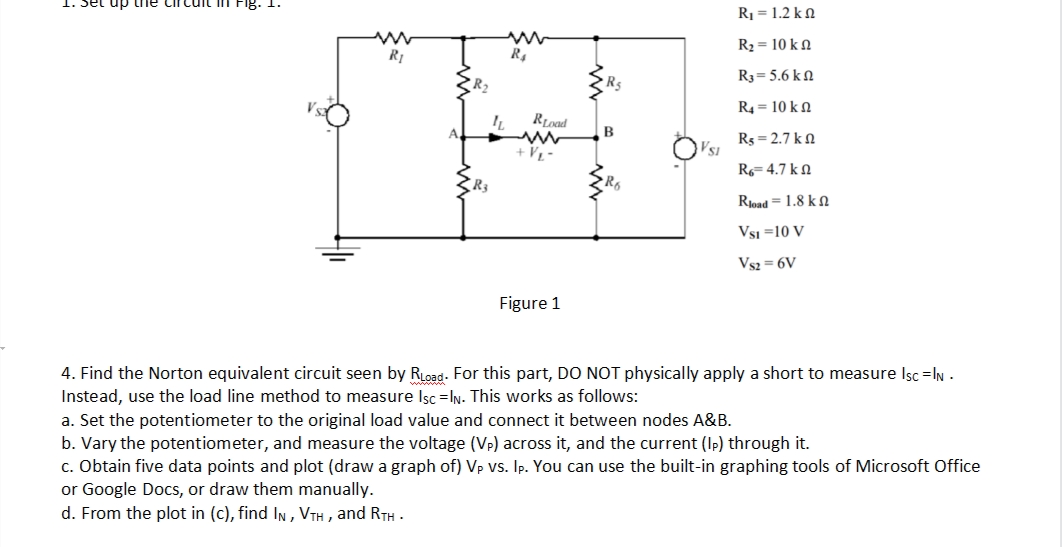4. Find the Norton equivalent circuit seen by RLoad. For this part, DO NOT physically apply a short to measure Isc =IN - Instead, use the load line method to measure Isc =IN. This works as follows: a. Set the potentiometer to the original load value and connect it between nodes A&B. b. Vary the potentiometer, and measure the voltage (Vp) across it, and the current (Ip) through it. c. Obtain five data points and plot (draw a graph of) Vp Vs. Ip. You can use the built-in graphing tools of Microsoft Office or Google Docs, or draw them manually. d. From the plot in (c), find In , VTH , and RTTH -
4. Find the Norton equivalent circuit seen by RLoad. For this part, DO NOT physically apply a short to measure Isc =IN - Instead, use the load line method to measure Isc =IN. This works as follows: a. Set the potentiometer to the original load value and connect it between nodes A&B. b. Vary the potentiometer, and measure the voltage (Vp) across it, and the current (Ip) through it. c. Obtain five data points and plot (draw a graph of) Vp Vs. Ip. You can use the built-in graphing tools of Microsoft Office or Google Docs, or draw them manually. d. From the plot in (c), find In , VTH , and RTTH -
Introductory Circuit Analysis (13th Edition)
13th Edition
ISBN:9780133923605
Author:Robert L. Boylestad
Publisher:Robert L. Boylestad
Chapter1: Introduction
Section: Chapter Questions
Problem 1P: Visit your local library (at school or home) and describe the extent to which it provides literature...
Related questions
Question
Answer please

Transcribed Image Text:dn jas
R1 = 1.2 k N
R2 = 10 k N
R1
R4
R3= 5.6 k N
R5
R4 = 10 k N
B
Rs = 2.7 kN
+ V½ -
R= 4.7 kN
Rjoad = 1.8 k N
Vsi =10 V
Vs2 = 6V
Figure 1
4. Find the Norton equivalent circuit seen by RLoad. For this part, DO NOT physically apply a short to measure Isc =IN -
Instead, use the load line method to measure Isc =IN. This works as follows:
a. Set the potentiometer to the original load value and connect it between nodes A&B.
b. Vary the potentiometer, and measure the voltage (Vp) across it, and the current (Ip) through it.
c. Obtain five data points and plot (draw a graph of) Vp vs. Ip. You can use the built-in graphing tools of Microsoft Office
or Google Docs, or draw them manually.
d. From the plot in (c), find In , VTH , and RTH -
Expert Solution
This question has been solved!
Explore an expertly crafted, step-by-step solution for a thorough understanding of key concepts.
Step by step
Solved in 2 steps with 9 images

Knowledge Booster
Learn more about
Need a deep-dive on the concept behind this application? Look no further. Learn more about this topic, electrical-engineering and related others by exploring similar questions and additional content below.Recommended textbooks for you

Introductory Circuit Analysis (13th Edition)
Electrical Engineering
ISBN:
9780133923605
Author:
Robert L. Boylestad
Publisher:
PEARSON

Delmar's Standard Textbook Of Electricity
Electrical Engineering
ISBN:
9781337900348
Author:
Stephen L. Herman
Publisher:
Cengage Learning

Programmable Logic Controllers
Electrical Engineering
ISBN:
9780073373843
Author:
Frank D. Petruzella
Publisher:
McGraw-Hill Education

Introductory Circuit Analysis (13th Edition)
Electrical Engineering
ISBN:
9780133923605
Author:
Robert L. Boylestad
Publisher:
PEARSON

Delmar's Standard Textbook Of Electricity
Electrical Engineering
ISBN:
9781337900348
Author:
Stephen L. Herman
Publisher:
Cengage Learning

Programmable Logic Controllers
Electrical Engineering
ISBN:
9780073373843
Author:
Frank D. Petruzella
Publisher:
McGraw-Hill Education

Fundamentals of Electric Circuits
Electrical Engineering
ISBN:
9780078028229
Author:
Charles K Alexander, Matthew Sadiku
Publisher:
McGraw-Hill Education

Electric Circuits. (11th Edition)
Electrical Engineering
ISBN:
9780134746968
Author:
James W. Nilsson, Susan Riedel
Publisher:
PEARSON

Engineering Electromagnetics
Electrical Engineering
ISBN:
9780078028151
Author:
Hayt, William H. (william Hart), Jr, BUCK, John A.
Publisher:
Mcgraw-hill Education,